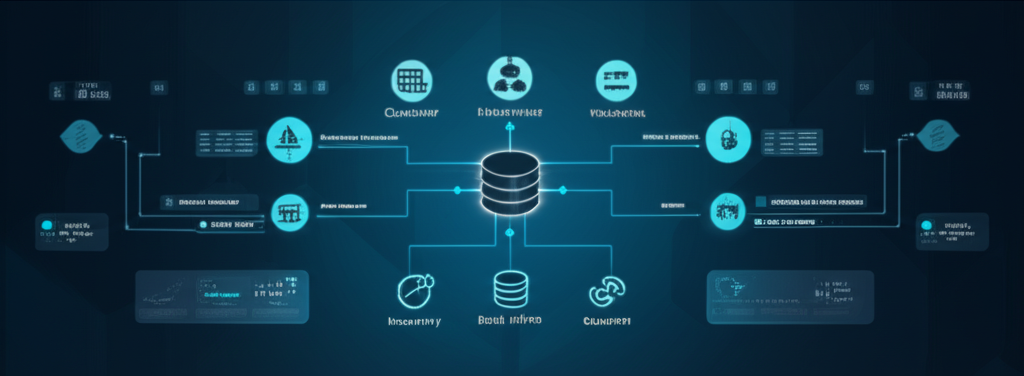Introduction: The Integration Imperative
In today's hypercompetitive business landscape, operational excellence is no longer optional—it's essential for survival. At the heart of this pursuit lies a critical challenge: how to unify the disparate systems that manage customer relationships and internal operations. Customer Relationship Management (CRM) and Enterprise Resource Planning (ERP) systems represent the two pillars of enterprise software, yet they often exist as separate islands of information, creating inefficiencies and missed opportunities.
The integration of these systems isn't merely a technical exercise—it's a strategic imperative that can transform how businesses operate, serve customers, and compete in the marketplace. At Scalefiniti, we've guided numerous organizations through this integration journey, witnessing firsthand the profound impact it can have on operational efficiency, customer satisfaction, and bottom-line results.
Understanding the CRM-ERP Divide
Before exploring integration strategies, it's essential to understand the fundamental differences between these systems and why they've traditionally existed separately:
CRM Systems: The Front Office
CRM platforms focus on customer-facing processes and data:
- Managing customer and prospect information
- Tracking sales opportunities and pipelines
- Facilitating marketing campaigns and lead generation
- Supporting customer service interactions
- Analyzing customer behavior and preferences
These systems are typically designed for ease of use by sales, marketing, and customer service teams, with interfaces optimized for quick data entry and retrieval during customer interactions.
ERP Systems: The Back Office
ERP platforms manage internal operations and resources:
- Financial management and accounting
- Inventory and supply chain management
- Production planning and execution
- Human resources and payroll
- Procurement and vendor relationships
These systems prioritize data integrity, compliance, and process standardization, often with more complex interfaces designed for specialized roles within finance, operations, and administration.
The Cost of Disconnection
When these systems remain separate, organizations face numerous challenges:
- Data inconsistency: Customer information, product details, and pricing often differ between systems, leading to errors and confusion.
- Process inefficiency: Manual data transfer between systems creates delays and introduces errors.
- Limited visibility: Sales teams lack insight into inventory levels and order status; operations teams have limited visibility into customer requirements and expectations.
- Missed opportunities: Without a complete view of customer interactions and operational capabilities, organizations fail to identify cross-selling opportunities or operational improvements.
- Customer experience degradation: Disconnected systems lead to fragmented customer experiences, with different departments unable to access complete customer information.
The Business Case for Integration
The integration of CRM and ERP systems delivers substantial benefits across multiple dimensions of business performance:
1. Enhanced Operational Efficiency
Integration eliminates redundant data entry and manual processes. Information entered once propagates automatically to all relevant systems, reducing administrative overhead and minimizing errors.
A manufacturing client we worked with reduced order processing time by 68% after integrating their CRM and ERP systems. Sales representatives now enter orders directly in the CRM, which automatically validates inventory availability in the ERP and initiates fulfillment processes without manual intervention.
2. Improved Customer Experience
With integrated systems, every customer-facing employee has access to complete, up-to-date information about customer interactions, orders, invoices, and service history. This enables more informed conversations and faster resolution of customer inquiries.
A distribution company saw a 42% reduction in customer service response times after integration, as representatives gained immediate access to order status, shipping information, and invoice details directly from their CRM interface.
3. Data-Driven Decision Making
Integration creates a unified data foundation that supports more sophisticated analytics and reporting. Leaders gain visibility into the complete customer journey, from marketing engagement through sales, fulfillment, billing, and support.
One retail client discovered that their most profitable customer segment was experiencing the longest order fulfillment times—an insight that was impossible to uncover before integration. Addressing this issue led to a 15% increase in repeat purchases from this high-value segment.
4. Accelerated Cash Flow
Integration streamlines the quote-to-cash process, reducing delays between sales, fulfillment, invoicing, and payment collection. This acceleration can significantly improve working capital efficiency.
A professional services firm reduced their average days sales outstanding (DSO) by 9 days after integration, improving cash flow and reducing the need for working capital financing.
5. Scalable Growth
Integrated systems provide the foundation for scalable growth, allowing organizations to increase transaction volumes and enter new markets without proportional increases in administrative overhead.
A technology company was able to expand into three new international markets without adding finance or operations staff, as their integrated systems automatically handled multi-currency transactions, country-specific tax rules, and localized fulfillment processes.
Integration Approaches: Finding the Right Strategy
There is no one-size-fits-all approach to CRM-ERP integration. The optimal strategy depends on an organization's specific systems, business requirements, technical capabilities, and budget constraints. Here are the primary approaches we consider:
1. Point-to-Point Integration
This approach involves direct connections between specific modules or functions in the CRM and ERP systems. It's typically focused on high-priority data flows, such as customer master data, product information, or order details.
Best for: Organizations with limited integration needs or budget constraints, seeking to address specific pain points rather than comprehensive integration.
Considerations: While simpler to implement initially, point-to-point integrations can become complex and difficult to maintain as the number of connections grows.
2. Middleware/ESB Solutions
Enterprise Service Bus (ESB) or middleware platforms serve as intermediaries between CRM and ERP systems, managing data transformation, routing, and orchestration. This approach provides a more flexible and scalable integration architecture.
Best for: Organizations with multiple systems to integrate beyond just CRM and ERP, or those anticipating significant changes to their system landscape over time.
Considerations: Requires investment in additional technology and specialized skills, but offers greater flexibility and future-proofing.
3. API-Based Integration
Modern CRM and ERP systems increasingly offer robust APIs (Application Programming Interfaces) that facilitate integration. This approach leverages these native capabilities to create real-time or near-real-time data synchronization.
Best for: Organizations using modern, cloud-based systems with comprehensive API capabilities.
Considerations: Depends on the quality and completeness of available APIs; may require custom development to address gaps.
4. Data Warehouse Integration
Rather than directly connecting operational systems, this approach extracts data from both CRM and ERP into a central data warehouse for reporting and analytics purposes. While it doesn't address real-time operational integration, it provides a unified view for decision-making.
Best for: Organizations primarily focused on analytical insights rather than operational process integration.
Considerations: Introduces data latency, making it unsuitable for real-time operational needs.
5. Unified Platform Adoption
Some vendors now offer comprehensive platforms that include both CRM and ERP functionality, designed to work together seamlessly. Migrating to such a platform represents a more transformative approach to integration.
Best for: Organizations undergoing major system modernization or those willing to standardize on a single vendor's ecosystem.
Considerations: Represents a significant change management challenge but eliminates many integration complexities.
Implementation Best Practices: Ensuring Integration Success
Based on our experience guiding numerous CRM-ERP integration initiatives, we've identified several critical success factors:
1. Start with Process, Not Technology
Successful integration begins with a clear understanding of business processes that span both systems. Map current processes, identify pain points and inefficiencies, and design optimized future-state processes before selecting technical integration approaches.
2. Prioritize Based on Business Impact
Not all integration points deliver equal value. Prioritize based on potential business impact, focusing first on areas that directly affect customer experience, revenue generation, or significant operational inefficiencies.
3. Establish Clear Data Governance
Determine which system will be the "system of record" for different data elements, establish data quality standards, and implement processes to maintain data integrity across systems.
4. Adopt an Incremental Approach
Rather than attempting a "big bang" integration, consider a phased approach that delivers value incrementally while managing risk. Start with high-impact, lower-complexity integration points to build momentum and demonstrate value.
5. Invest in Change Management
Integration changes how people work. Invest in comprehensive change management, including stakeholder engagement, training, and clear communication about how integration will benefit different roles and departments.
6. Plan for Ongoing Maintenance and Evolution
Integration is not a one-time project but an ongoing capability that requires maintenance and evolution. Establish clear ownership, monitoring processes, and governance to ensure long-term success.
Future Trends: The Evolution of Enterprise Software Integration
As we look to the future, several trends are shaping the evolution of CRM-ERP integration:
1. AI-Enhanced Integration
Artificial intelligence is increasingly being applied to integration challenges, from intelligent data mapping and transformation to anomaly detection and predictive insights across integrated data sets.
2. Low-Code/No-Code Integration Platforms
The emergence of low-code/no-code integration platforms is democratizing integration capabilities, allowing business users to create and modify integrations without deep technical expertise.
3. Event-Driven Architectures
Modern integration approaches are moving toward event-driven architectures, where systems publish events that trigger actions in other systems, creating more responsive and resilient integration patterns.
4. Composable Enterprise Applications
The concept of the "composable enterprise" envisions a future where applications are assembled from modular capabilities rather than monolithic systems, potentially blurring the traditional boundaries between CRM and ERP.
Conclusion: Integration as Strategic Advantage
The integration of CRM and ERP systems represents far more than a technical challenge—it's a strategic opportunity to transform how organizations operate, serve customers, and compete in the marketplace. By breaking down the traditional barriers between customer-facing and operational systems, businesses can achieve new levels of efficiency, agility, and customer-centricity.
As enterprise software continues to evolve, the organizations that thrive will be those that view integration not as a one-time project but as an ongoing capability that enables continuous innovation and adaptation. The path to operational excellence begins with a unified view of customers, operations, and finances—a view that only becomes possible when CRM and ERP systems work together and finances—a view that only becomes possible when CRM and ERP systems work together as an integrated whole.
The journey may be complex, but the destination—a truly integrated enterprise that can respond seamlessly to customer needs while optimizing internal operations—is well worth the effort. In an era where customer expectations and competitive pressures continue to rise, CRM-ERP integration isn't just a technical necessity; it's a business imperative.


